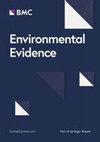Recovery of plant nutrients from human excreta and domestic wastewater for reuse in agriculture: a systematic map and evidence platform
IF 5.2
4区 环境科学与生态学
Q2 ENVIRONMENTAL SCIENCES
引用次数: 0
Abstract
Achieving a more circular and efficient use of nutrients found in human excreta and domestic (municipal) wastewater is an integral part of mitigating aquatic nutrient pollution and nutrient insecurity. A synthesis of research trends readily available to various stakeholders is much needed. This systematic map collates and summarizes scientific research on technologies that facilitate the recovery and reuse of plant nutrients and organic matter found in human excreta and domestic wastewater. We present evidence in a way that can be navigated easily. We hope this work will help with the uptake and upscaling of new and innovative circular solutions for the recovery and reuse of nutrients. The systematic map consists of an extension of two previous related syntheses. Searches were performed in Scopus and Web of Science in English. Records were screened on title and abstract, including consistency checking. Coding and meta-data extraction included bibliographic information, as well as recovery pathways. The evidence from the systematic map is embedded in an online evidence platform that, in an interactive manner, allows stakeholders to visualize and explore the systematic map findings, including knowledge gaps and clusters. The evidence base includes a total of 10 950 articles describing 11 489 recovery pathways. Most of the evidence base is about recovery technologies (41.9%) and the reuse of recovered products in agriculture (53.4%). A small proportion of the evidence base focuses on the characteristics of recovered products (4.0%) and user acceptance and perceptions of nutrient recovery and reuse (0.7%). Most studies we mapped focused on nutrient recovery from ‘conventional’ systems, that is, from centralized sewer and wastewater treatment systems that produce biosolids and a treated effluent. While we also found substantial research on nutrient recovery from source-separated urine, and to some extent also on nutrient recovery from source-separated excreta (notably blackwater), the body of research on nutrient recovery from source-separated feces was relatively small. Another knowledge gap is the relative lack of research on the recovery of potassium. More research is also needed on user acceptance of different recovery technologies and recovered products.从人类排泄物和生活废水中回收植物养分用于农业再利用:系统图和证据平台
更循环、更高效地利用人类排泄物和家庭(城市)废水中的营养物质,是减轻水生营养物质污染和营养物质不安全的一个组成部分。各利益相关方亟需一份研究趋势综述。本系统图整理并总结了有关技术的科学研究,这些技术有助于回收和再利用人类排泄物和生活废水中的植物养分和有机物。我们以易于浏览的方式展示证据。我们希望这项工作将有助于吸收和推广新的、创新的养分回收和再利用循环解决方案。该系统地图是对之前两份相关综述的扩展。在 Scopus 和 Web of Science 中进行了英文检索。根据标题和摘要对记录进行筛选,包括一致性检查。编码和元数据提取包括书目信息以及康复途径。系统地图中的证据已嵌入在线证据平台,通过互动方式,利益相关者可以直观地了解和探索系统地图的发现,包括知识差距和群组。证据库共包括 10 950 篇文章,描述了 11 489 种康复途径。证据库的大部分内容涉及回收技术(41.9%)和回收产品在农业中的再利用(53.4%)。证据基础的一小部分侧重于回收产品的特征(4.0%)以及用户对养分回收和再利用的接受程度和看法(0.7%)。我们绘制的大多数研究都侧重于从 "传统 "系统中进行养分回收,即从产生生物固体和处理过的污水的集中式下水道和废水处理系统中进行养分回收。虽然我们也发现了大量关于从源分离的尿液中回收营养物质的研究,以及在一定程度上关于从源分离的排泄物(尤其是黑水)中回收营养物质的研究,但关于从源分离的粪便中回收营养物质的研究却相对较少。另一个知识空白是相对缺乏对钾回收的研究。还需要对用户对不同回收技术和回收产品的接受程度进行更多研究。
本文章由计算机程序翻译,如有差异,请以英文原文为准。
求助全文
约1分钟内获得全文
求助全文
来源期刊

Environmental Evidence
Environmental Science-Management, Monitoring, Policy and Law
CiteScore
6.10
自引率
18.20%
发文量
36
审稿时长
17 weeks
期刊介绍:
Environmental Evidence is the journal of the Collaboration for Environmental Evidence (CEE). The Journal facilitates rapid publication of evidence syntheses, in the form of Systematic Reviews and Maps conducted to CEE Guidelines and Standards. We focus on the effectiveness of environmental management interventions and the impact of human activities on the environment. Our scope covers all forms of environmental management and human impacts and therefore spans the natural and social sciences. Subjects include water security, agriculture, food security, forestry, fisheries, natural resource management, biodiversity conservation, climate change, ecosystem services, pollution, invasive species, environment and human wellbeing, sustainable energy use, soil management, environmental legislation, environmental education.
 求助内容:
求助内容: 应助结果提醒方式:
应助结果提醒方式:


